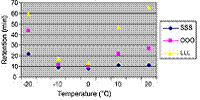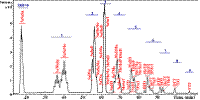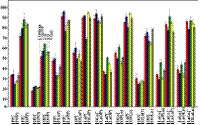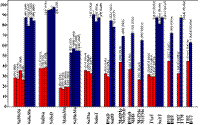

![Text Box: SILVER-ION HIGH-PERFORMANCE LIQUID CHROMATOGRAPHY -
MASS SPECTROMETRY IN THE ANALYSIS OF LIPIDS
MICHAL HOLčAPEK AND MIROSLAV LiSA
UNIVERSITY OF PARDUBICE, FACULTY OF CHEMICAL TECHNOLOGY, DEPARTMENT OF ANALYTICAL
CHEMISTRY, PARDUBICE, CZECH REPUBLIC
Introduction
The ability of silver-ion and some other metal-ions to interact with double
bonds (DBs) has been a well known property for a long time (Dobson et al.,
1995; Guha & Janak, 1972; Devries, 1962; Morris, 1962). Silver-ion chromatography,
sometimes called argentation chromatography, is a separation technique
based on the formation of weak reversible charge-transfer complexes
between silver-ion and DBs of unsaturated organic molecules. Silver-ion chromatography can be performed either in a planar arrangement (silver-ion thin
layer chromatography, Ag-TLC) or on column [used mainly for preparative
purposes or silver-ion high-performance liquid chromatography (Ag-HPLC)
used for high-resolution separations]. Ag-TLC is a well-established technique
in the lipid analysis because it is cheap, simple to use and applicable both in
analytical and preparative scale. Disadvantages of Ag-TLC are mainly the contamination
of fractions in the preparative isolation by silver and the limited
resolution of TLC technique. Ag-TLC has been reviewed in several works
(Dobson et al., 1995; Momchilova & Nikolova-Damyanova, 2003), therefore it
is not discussed in this chapter.
The retention in the Ag-HPLC is governed by the DB number. More DBs
mean stronger interactions and therefore higher retention times. In practice,
the situation is not as simple because other factors have to be taken into
account, such as the DB geometry (cis vs. trans), distances among individual
DBs (from the conjugation to remote DBs), overall molecular structures, the
type of stationary phase, the composition of mobile phase, the gradient steepness,
separation temperature, etc. The vast majority of Ag-HPLC applications
is in the area of lipids, but this technique can be used for other compounds
containing DBs as well (Guha & Janak, 1972; Williams & Mander, 2001). This
chapter focuses solely on lipids, mainly triacylglycerols (TGs), fatty acids (FAs)
and their simple derivatives such as fatty acid methyl esters (FAMEs).](image1074.gif)

|
This was a sample page from the book to give you an idea of what is discussed. To learn more about Silver-Ion HPLC-MS for Lipid Analysis, Buy the Book! |
|
Contact the authors:
Prof. Dr. Michal Holcapek Dr. Miroslav Lisa c/o AOCS Press P.O. Box 17190 Urbana, IL 61803-7190
Phone: 217-359-2344 E-mail: sales@aocs.com Web address: |





